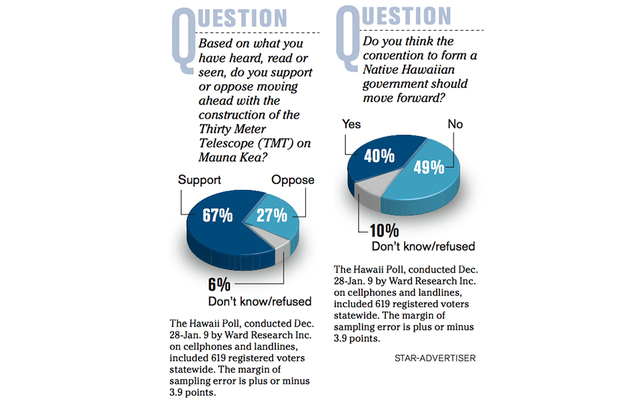A substantial majority of Hawaii residents supports the construction of the Thirty Meter Telescope, while a plurality opposes a convention that aims to form a Native Hawaiian government.
But it’s a different story for Native Hawaiians, most of whom oppose the telescope while a narrow majority supports the Na‘i Aupuni convention, or aha.
Those are some of the findings of the Hawaii Poll, the Honolulu Star-Advertiser’s latest scientific survey, conducted Dec. 28 through Jan. 9.
Some 67 percent of the 619 registered voters queried by Ward Research Inc. of Honolulu said they support moving ahead with construction of the next-generation telescope, while only 27 percent oppose it and 6 percent offered no opinion.
The results show even stronger support for the $1.4 million project than the poll commission by TMT representatives in October, when 62 percent of Hawaii adults said they backed construction.
In both cases, Ward Research was hired to conduct the survey.
Rebecca Ward, president of Ward Research, which has conducted the Hawaii Poll since 1997, said that when the Star-Advertiser asked that a TMT question be included this time, she suggested using the identical question for comparison of the data. The newspaper agreed.
Although more than two-thirds of the state’s registered voters offered support for the telescope in the new poll, most of the Native Hawaiians who were asked did not. Some 59 percent of Hawaiians said they oppose the TMT’s construction, while 39 percent offered support. Just 2 percent declined to give an opinion.
That’s an increase in Native Hawaiian opposition over the October poll, when 49 percent opposed the TMT and 44 percent were favorable.
The October poll was conducted during a long break in construction, caused in part by protesters blocking repeated attempts by the TMT’s builders to access the mountaintop work site. TMT officials said they wanted to gauge public support for the project.
Since that time, the Hawaii Supreme Court invalidated the project’s conservation district use permit, a major setback that could stall construction for years.
TMT officials are now trying to figure out what to do next, said Henry Yang, chairman of the TMT board of directors.
“We are grateful for the community’s continued strong support, which is growing ever stronger. It demonstrates the great value that astronomy brings to the islands and the rest of the world. As we are assessing our next steps forward, we thank the people of Hawaii and all of our supporters,” Yang said in a statement.
Regarding the Native Hawaiian convention, 49 percent of those surveyed were opposed, while 40 percent backed the effort. Ten percent had no opinion.
When Native Hawaiians were asked, the answers were split, but supporters exceeded foes 48 percent to 45 percent.
Na‘i Aupuni President Kuhio Asam said he and many other Native Hawaiians remain committed to the project.
“We respect all in our community, but Na‘i Aupuni believes that a discussion on self-governance by Hawaiians is important for Native Hawaiians and the state as a whole. The attendees of the aha represent a wide spectrum of views from the Native Hawaiian community and we look forward to that dialogue,” Asam said in a statement.
The four-week convention is scheduled to start Feb. 1 with at least 154 delegates.
But the effort is still being targeted by litigation, and the U.S. Supreme Court, which on Friday considered a request for Na‘i Aupuni to be held in civil contempt, could still block the convention.
Lawsuit plaintiff Kelii Akina, president of the Grassroot Institute of Hawaii, said, “Clearly, there is no consensus for the Na‘i Aupuni convention, even among Native Hawaiians. The citizens of Hawaii do not want a government- funded, racially exclusive process that divides rather than unites. Instead, most people in Hawaii want to preserve the Hawaiian value of aloha.”
Hawaii Poll — TMT & Hawaiian election




